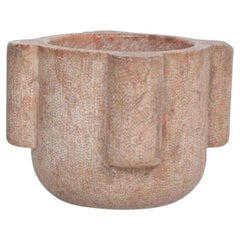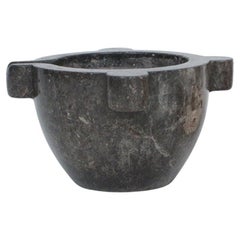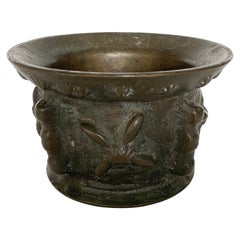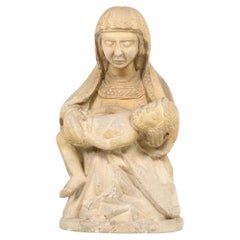16th Century Urns
6
to
4
2
6
6
6
90
1,188
933
389
281
289
167
50
16
43
35
32
34
50
37
26
8
Height
to
Width
to
4
2
2
1
1
5
3
1
1
1
Period: 16th Century
Large Stone Mortar 16th Century
Located in Bonita Springs, FL
This very large and unique stone mortar from the 16th century has a beautiful and rare color palette. Earth tones accentuate the color layers of the marble. This piece has a great pa...
Category
Danish Antique 16th Century Urns
Materials
Stone, Marble
Very Large Granite Stone Mortar 16th Century
Located in Bonita Springs, FL
This very large and unique granite stone mortar from the 16th century has a beautiful and rare color palette. This impressive piece has a great patina and character. It looks impress...
Category
French Antique 16th Century Urns
Materials
Stone, Granite
16th Century Spanish Cast Bronze Apothecary Mortar
Located in Kensington, MD
This rare example of a Renaissance bronze mortar is decorated with starbursts all along the everted rim and features 4 large starbursts on the sides between the ribbed handles. The c...
Category
Italian Renaissance Antique 16th Century Urns
Materials
Bronze
Pair of Islamic Enameled Vessels, Ancient Urns
Located in Vero Beach, FL
This is an exceptional and historic pair of Damascus enameled metalwork vessels or urns. These art objects show signs of rough use and handling through the centuries. Although it is ...
Category
West Asian Islamic Antique 16th Century Urns
Materials
Enamel
Mortar and Pilar End 15th Century Gothic Period
Located in Brussels, Brussels
Iron mortar with its original pestle end 15th beginning 16th century Gothic period, France
Beautiful original object with a beautiful patina and in good condition
Category
French Gothic Antique 16th Century Urns
Materials
Iron
Iron Mortar, circa 1600 with Its Original Base
Located in Brussels, Brussels
Interesting iron mortar with its original base
French Renaissance mortar, circa 1600
This beautiful object is composed of its iron mortar which is 28cm high and its base which ...
Category
French Renaissance Antique 16th Century Urns
Materials
Iron
Related Items
Stone 17th Century Mortar
Located in Vosselaar, BE
A French Primitive mortar in sandstone dating from the 17th century.
Category
French Antique 16th Century Urns
Materials
Sandstone
Spanish Sculpture "Pieta" 16th Century
Located in Madrid, ES
Spanish sculpture "Pieta"
16th century
sculpture in stone
Nossa Senhora, is represented seated securing Jesus Christ.
Measure: Height: 52 cm.
Very good condition.
Category
Spanish Gothic Antique 16th Century Urns
Materials
Stone
Polychrome carved wood Virgin and Child from the 15th Century
Located in Saint-Ouen, FR
POLYCHROME CARVED WOOD VIRGIN AND CHILD FROM THE 15TH CENTURY
ORIGIN: SOUTH GERMANY, SWABIA, NUREMBERG REGION
PERIOD: 15th CENTURY
Height: 94,6cm
Width : 28 cm
Depth : 18 cm
Lime wood
Original Polychromy
Good state of conservation
From 1430 onwards, sculpture underwent a profound stylistic renewal which continued until 1530, the so-called late Gothic period. In the Germanic countries, original sculptures flourished in an expressive and sensitive vein.
This renewal was inspired by the art of Nicholas of Leiden, who was active in Strasbourg in the 1460's. His style broke with the refined and delicate art of the international Gothic style in force throughout Europe around 1400. The figures became more authentic and realistic. The bodies became denser. Clothes are animated by deep, broken folds, the fabrics are heavy and have a great decorative value. In addition, the polychromy is intended to be illusionistic. The painting makes it possible to restore the texture of the materials, the richness of the textiles and the natural skin tone of the characters.
The dissemination of images through engraving and the great mobility of the artists led to the success of this style, which conquered the Upper Rhine, Swabian, Tyrolean and Franconian regions, contributing to the formation of a common stylistic identity in these regions. The economic boom in the flourishing German cities was conducive to the development of original production. Attracted by this prosperity, numerous workshops were set up in order to meet the orders of religious communities, the Church and the laity, including a clientele of middle-class rockers.
This precious Virgin and Child is depicted standing on a crescent moon, her head encircled by a crown of tall flowers. Her long wavy hair spreads over her shoulders, framing her beautiful oval face. Under fine eyebrows drawn with a brushstroke, her almond-shaped, slightly drooping eyes look at the Child with infinite softness. She is dressed in a long red dress with a rounded neckline, belted under the chest. The heavy fabric of her dress spreads out in broken folds at her feet. On her shoulders she wears a golden cloak. The drapery has deep folds. She holds out her right hand while she holds the Christ Child with her left.
Christ, with his well-defined hair, is naked. His cheeks are highlighted with red, he holds an apple in his left hand and with the other hand makes a sign of blessing towards the faithful.
Virgins with Child on a crescent moon were very popular in the second half of the 15th century, especially as the central subject of altarpieces in southern Germany and Austria. The crescent moon on which Mary is standing is reminiscent of the Woman of the Apocalypse. Often equated with the Virgin Mary.
This episode is taken from the Book of Revelation (12:1-6)
1 Then a great sign appeared in heaven: a woman clothed with the sun, with the moon under her feet and a crown of twelve stars on her head. ; 2 She was pregnant, and she cried out because she was in labor, in pain from giving birth. ; 3 Then another sign appeared in heaven: it was a great fiery red dragon, with seven heads and ten horns, and seven royal crowns on his heads. ; 4 His tail swept down a third of heaven's stars and threw them to the earth. The dragon stood in front of the woman who was about to give birth so that when she gave birth, he might devour her child. ; 5 She gave birth to a son, a male child who is to rule all the nations with an iron rod. Her child was snatched up to God and his throne. ; 6 Then the woman fled into the desert, where God has prepared a place for her. There she will be taken care of for one thousand two hundred sixty days.
Some theologians see in this woman a reference to the Virgin Mary and in the child, Jesus.
This remarkable work is a very fine example of sculpture from Swabian workshops in the last decades of the 15th century. It presents all the characteristic stylistic elements: a highly girdled silhouette, an abundant drapery with angular folds, but also a great physical presence accentuated by the polychromy that restores the anatomical details. This group is made of a wooden log. The deep folds of the drapery highlight the movement of the Virgin holding the child.
Bibliography :
Sophie Guillot de Suduiraut, Dévotion et Séduction, Sculptures souabes des musées de France, vers 1460-1530, Paris musée du Louvre-Éditions somogy, 2015
“Revelation 12 - Common English Bible...
Category
German Gothic Antique 16th Century Urns
Materials
Wood
Japanese Antique Pottery Jar 15th-16th Century/ Wabi-Sabi Jar/Tokoname Vase
Located in Sammu-shi, Chiba
It is a very old jar in Japan.
This is a pottery called Tokoname ware.
Tokoname is a kiln located in Aichi prefecture, Japan.
It is said to have originated around the 12th century.
A...
Category
Japanese Other Antique 16th Century Urns
Materials
Pottery
Lion of Forge, Spain, 16th Century
Located in Madrid, ES
Lion of Forge, Spain, 16th century
In forging, measurements: 10 x 17 x 5 cm
Good condition
Spanish private collection.
Category
Spanish Baroque Antique 16th Century Urns
Materials
Iron
Japanese antique pottery Wabisabi vase/15th century/Bizen ware/Muromachi period
Located in Sammu-shi, Chiba
I would like to introduce an attractive pot that gives you a sense of wabi-sabi.
It is "Shigaraki ware".
Shigaraki is a historical kiln located in Shiga Prefecture, Japan. (Shigaraki...
Category
Japanese Other Antique 16th Century Urns
Materials
Pottery
H 12.6 in Dm 12.41 in
Korean antique pottery black glaze vase/15th-16th century/small bottle
Located in Sammu-shi, Chiba
This is black glazed pottery made in Korea from around the 15th to 16th century.
This era in Korea is called the Joseon Dynasty.
This black glazed pottery was only produced for a sho...
Category
South Korean Other Antique 16th Century Urns
Materials
Pottery
Male Head, Carved Stone, Spain, 16th Century
Located in Madrid, ES
Male head. Carved stone. Century XVI.
Carved stone relief showing a male face turned to the right. It is necessary to highlight both the quality of the fac...
Category
Spanish Renaissance Antique 16th Century Urns
Materials
Stone
Korean antique black glaze pottery/Joseon period/15th-16th century/small vase
Located in Sammu-shi, Chiba
This is a small black-glazed jar made in Korea between the 15th and 16th centuries.
White porcelain is famous in Korea, but this was a type of porcelain that was only allowed to be u...
Category
South Korean Other Antique 16th Century Urns
Materials
Pottery
Vintage Turkish Enameled Bohemian Glass Hookah Base Vase
Located in North Hollywood, CA
Vintage Turkish enameled Bohemian glass hookah base vase.
Clear and gold enameled Bohemian glass hookah base, or flower vase.
Bohemian glass hookah ...
Category
Turkish Islamic 16th Century Urns
Materials
Blown Glass
Japanese antique pottery vase/14th-15th century/Tokoname ware/Wabi-Sabi
Located in Sammu-shi, Chiba
It is a very old jar in Japan.
This is a pottery called Tokoname ware.
Tokoname is a kiln located in Aichi prefecture, Japan.(Tokoname Kiln is marked with a red circle on the map.)
I...
Category
Japanese Other Antique 16th Century Urns
Materials
Pottery
Japanese Antique large Pottery Jar 14th-16th Century/ Wabi-Sabi Vase/Tokoname
Located in Sammu-shi, Chiba
Tokoname is an area in Aichi prefecture, Japan.
It was a pottery producing area with a very old history (from around the 12th century) in Japan.
This is a jar that was burned during ...
Category
Antique 16th Century Urns
Materials
Pottery
H 21.66 in Dm 18.51 in
Recently Viewed
View AllMore Ways To Browse
Bronze Urn With Lid
Pair Roman Urns
Bronze European Urns
Large Covered Urns
Swan Urn
Italian Bronze Urn
Marble Pedestals With Urns
White Urn Lided
Small Urn Gold
Sevres Vases And Urns
Ormolu French Neoclassical Urn
Sevres Urn Vase
Sevres Vase Urns
Porcelain Urns Pair Antique
Mid 19th Century Bronze Urns
Fluted Bronze Urn
Urn Pots
Antique Greek Urn






